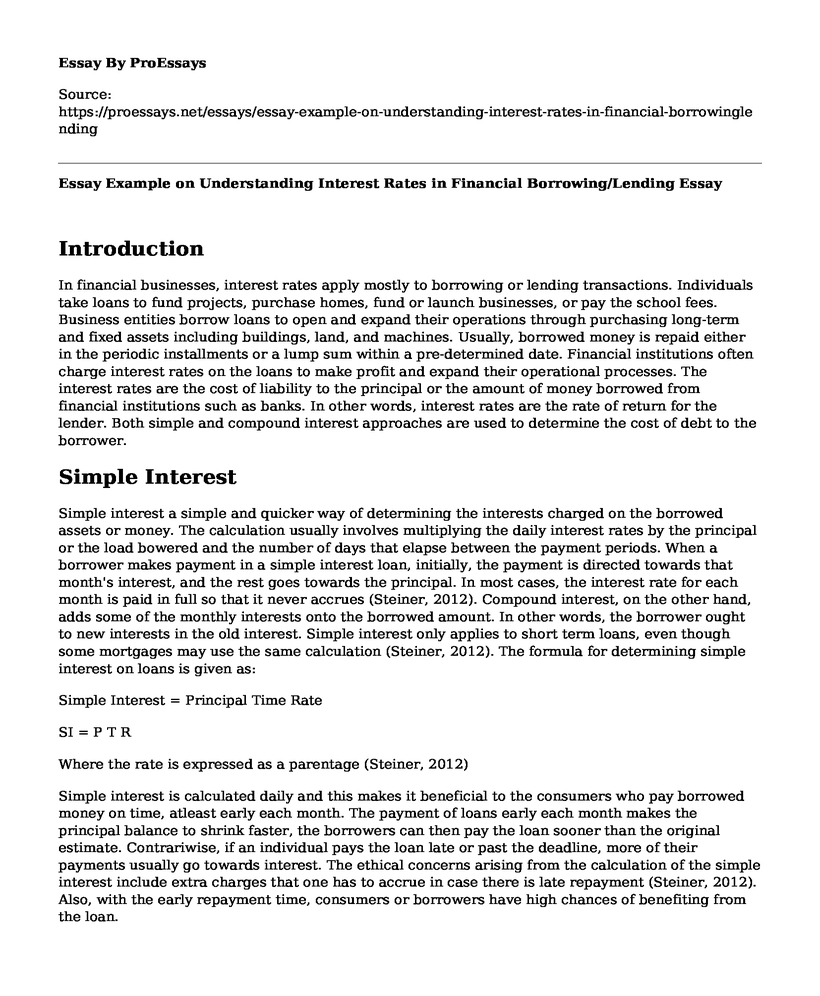Introduction
In financial businesses, interest rates apply mostly to borrowing or lending transactions. Individuals take loans to fund projects, purchase homes, fund or launch businesses, or pay the school fees. Business entities borrow loans to open and expand their operations through purchasing long-term and fixed assets including buildings, land, and machines. Usually, borrowed money is repaid either in the periodic installments or a lump sum within a pre-determined date. Financial institutions often charge interest rates on the loans to make profit and expand their operational processes. The interest rates are the cost of liability to the principal or the amount of money borrowed from financial institutions such as banks. In other words, interest rates are the rate of return for the lender. Both simple and compound interest approaches are used to determine the cost of debt to the borrower.
Simple Interest
Simple interest a simple and quicker way of determining the interests charged on the borrowed assets or money. The calculation usually involves multiplying the daily interest rates by the principal or the load bowered and the number of days that elapse between the payment periods. When a borrower makes payment in a simple interest loan, initially, the payment is directed towards that month's interest, and the rest goes towards the principal. In most cases, the interest rate for each month is paid in full so that it never accrues (Steiner, 2012). Compound interest, on the other hand, adds some of the monthly interests onto the borrowed amount. In other words, the borrower ought to new interests in the old interest. Simple interest only applies to short term loans, even though some mortgages may use the same calculation (Steiner, 2012). The formula for determining simple interest on loans is given as:
Simple Interest = Principal Time Rate
SI = P T R
Where the rate is expressed as a parentage (Steiner, 2012)
Simple interest is calculated daily and this makes it beneficial to the consumers who pay borrowed money on time, atleast early each month. The payment of loans early each month makes the principal balance to shrink faster, the borrowers can then pay the loan sooner than the original estimate. Contrariwise, if an individual pays the loan late or past the deadline, more of their payments usually go towards interest. The ethical concerns arising from the calculation of the simple interest include extra charges that one has to accrue in case there is late repayment (Steiner, 2012). Also, with the early repayment time, consumers or borrowers have high chances of benefiting from the loan.
Compound Interest
Unlike the simple interest compound interest involves the addition of the interest to the loan borrowed or the principal sum or the deposit. In some cases, it may involves the addition of interest on interest. While simple interest involves payment of interest accrued on the loan, compound interest results from the reinvesting on the interest instead of paying it out. The interest in the next period is then produced on the principal sum in addition to previously accrued interests. Compound interest is standards both in economics and fiance.
Compound interest is different from the simple interest in the sense that previously accrued interest is not added to the principal or borrowed loan amount of the present period. In other words, the determination of the does not involve compounding. Compounding interest is calculated on the principal, or the initial loan borrowed and includes the entire accumulated interests from the previous times or periods of the loan. Compound interest is determined through the multiplication of the original principal amount by one plus the yearly interest rate raised to the number of compound periods minus one. In other words, the formula for compound interest is given as:
A = P (1+rn)nt
A= Expected Amount
P = Principal or borrowed loan
R = interest rate N = number of times interest applied per period
T = time
(Steiner, 2012)The financial institutions make a lot of revenues from compound interest because, as time or period elapses, more interests are accrued, which the borrower ought to pay. The compounding of interests is always done on any given frequency schedule, from daily, monthly, quarterly to annually. However, there are standardized compounding frequency periods that are often applied within the financial processes.
The ethical concern that arises from compounding loans is that it works against the consumers who borrow loans with very high-interest rates including credit cards. In other words, consumers or borrowers are charged exorbitant interest on the loan borrowed, a situation that sometimes leads to that failure on the side of the borrower to honor the payment terms. The magic compounding only works to the advantage of financial institutions or money lenders. In other words, it is a potent factor when it comes to wealth creation. Alternatively, the exponential resulting from the compounding of interest is essential in moderating wealth-eroding factors such as inflation, increase in the cost of living, as well as the reduction in the purchasing power.
Reference
Steiner, B. (2012). Key Financial Market Concepts: The 100 terms every professional finance needs to know. Pearson UK.
Cite this page
Essay Example on Understanding Interest Rates in Financial Borrowing/Lending. (2023, Mar 02). Retrieved from https://proessays.net/essays/essay-example-on-understanding-interest-rates-in-financial-borrowinglending
If you are the original author of this essay and no longer wish to have it published on the ProEssays website, please click below to request its removal:
- Facebook Inc. vs. Twitter: Financial Comparison
- Analysis of the Financial Position of Nike Inc.
- Assignment Example on Mr. Jason's Financial Statements
- Ethics Auditing Essay Example
- Paper Example on Analyzing Conifer Corp: Signs of Trouble?
- Audit of Distributor's Stock: Substantive Procedure Needed - Essay Sample
- Essay Example on US Budget: Allocating Resources to Take Care of People's Needs







